As I write this, the temperature in Guildford is dropping down to -5°C or worse. In the winter, it’s the days when the skies are clear and blue that are the coldest.
With the cold, there’s also condensation. When the temperature drops outside, generally below 5°C overnight, you’ll start seeing condensation on your windows. You may notice this most in the bedroom, kitchen, bathroom or conservatory, especially early in the morning. Stopping condensation is one of the biggest problems homeowners face.
So, how can you stop condensation? The two main approaches to ‘curing’ or ‘stopping’ condensation are either to open the windows or use a dehumidifier. Open the windows may give pretty instant results but we’re letting in the cold air and then paying to heat it back up. Dehumidifiers provide a fast, effective and cost-efficient way to manage condensation.
Opening windows to deal with condensation
You would probably expect me to recommend that you buy a dehumidifier. I am a dehumidifier manufacturer after all. But let’s look at the benefits of opening windows first.
In Germany, they call it “Stoßlüften”, meaning “shock ventilation” and they may have the right idea about things… When people worry about condensation or mould problems, the advice will often be to open the window. This is to improve ventilation.
However, in some older properties that are often quite ‘leaky’, we can see that condensation is rarely an issue. I mean that in properties with older windows, we don’t always see more condensation. These windows might let in some moisture and may not be fully draft-proof. However, condensation is about trapped moisture inside the house, not extra moisture coming in.
Opening windows can cure condensation – but do you want to let the cold in?
So why does ventilation help? Opening windows can stop condensation – but do you want to let the cold in?
First, what causes condensation on windows?
Essentially, condensation occurs when air meets a cold surface and forms water on that surface. And it’s all about the relationship between relative humidity and temperature. In most cases, the surface is the cold glass panes of your windows and the relative humidity is moisture within your home. It doesn’t matter how little moisture there is in the air – if the surface is cold enough, you will get condensation.
Your windows provide the perfect cold surface because they are in direct contact with the chilly outside. If you touch the window pane, you’ll feel the difference!
This is why my windows at home have been free of condensation for months. Now the temperature has dropped, I can suddenly see condensation. I doubt that the amount of moisture in the air in my home has increased. It is just that the surface temperature of the window is lower during a cold spell.
This is also why you’ll find double-glazed windows usually have less condensation than single-glazed ones. This is because the two panes form an insulated barrier. And as a result, the inside pane isn’t quite as cold and condensation is less likely to occur. Remember that double-glazing condensation can still happen, it’s just less frequent than single glazing. This does not mean your windows are broken but there are steps you can take to reduce it.
What is the science behind condensation: the relationship between humidity and temperature?
Condensation forming on cold surfaces happens because of the inverse relationship between temperature and relative humidity. As temperature falls, relative humidity increases and as temperatures increase, relative humidity falls. So if you heat air up, the relative humidity will decrease. This is the key to the reason why ventilation can help cure condensation.
So, there are two things helping to form condensation, the temperature of a cold surface (your windows) and relative humidity. Of these, which can we control in order to stop condensation?
Unless you have fancy heated windows, then the answer is relative humidity. You can do this in a few ways. Let’s start with opening the window.
Does opening the window stop condensation?
Ultimately, yes. You’ll quickly notice the condensation leaving the windows. The air in your home is full of moisture from cooking, bathing, showering, drying washing and even breathing. The air outside in winter will probably have a lower relative humidity. So when you open the windows, warm, damp air goes out and cold air comes in.
Condensation can build up easily on any cold surface, especially windows throughout winter.
But now your room is a lot colder and you don’t know whether the outside air has changed your room’s relative humidity.
Have we helped to reduce the condensation situation? The answer is still yes. If you’re having a hot shower and open the window a smidge, you can watch the condensation reduce dramatically.
It is also because we are not going to let the air stay cold. We will heat it up to a temperature that we are comfortable with.
Even if the air outside is freezing, I still want it to be about 20°C in my house but I’ve opened the window and let some of that cold air in. I will warm it up and I’ll turn the heating on.
And in the laws of science, increased temperature means decreased relative humidity. If we assume the incoming air is full of moisture, warming it up will reduce that relative humidity as well. Let’s say the incoming air has a relative humidity around 90%rh, increasing the temperature will reduce it down to something like 25%rh.
So, all is good! We have got rid of our warm damp air, replaced it with cold damp air and warmed it up. We now have warm dry air. There’s a cure for condensation.
Opening the windows will work and is an effective solution to condensation control.
But..
Think about what we have just done. We have heated the air, costing us money, and then we have thrown that heated air out of the window. It might have been easier to throw fivers into the street!
To replace it, we have introduced freezing cold air into our home and made ourselves feel very uncomfortable.
Now, we need to warm the cold air. This will help us feel comfortable again and lower the humidity. This costs more money in energy, and later in the day, we’ll have to do it all over again. In fact, ideally you will have to do this in every room in the house. You will certainly need to do it in the bathroom, kitchen and bedrooms at the very least.
Opening the windows does work but I am not a fan because of two reasons. One, it makes people feel uncomfortable. Secondly, there’s a huge hidden cost of reheating the fresh air coming in from outside. With energy bills skyrocketing it seems a real waste of money to keep on throwing the energy outside.
Is a dehumidifier a better way to stop or prevent condensation?
Yes, a dehumidifier is a superb way to manage relative humidity in your home and reduce condensation. Plus, a dehumidifier is the only way you’ll remove moisture. As we mentioned earlier: condensation occurs because of temperature and relative humidity. You are unlikely to control the temperature of your windows, but you can manage relative humidity with a dehumidifier. Making a dehumidifier an incredibly effective choice to prevent condensation.
Running a dehumidifier does of course have a cost to it. There is an initial price of the unit, and then there’s the electricity cost to run it.
But there is an important difference between the cost of running a dehumidifier and the cost of heating air.
MeacoDry ABC Dehumidifier extracting excess moisture and preventing condensation from occurring
- Some dehumidifiers create a little warmth while dehumidifying. Desiccant dehumidifiers create around 12°C which is ideal especially in garages and conservatories.
- If you’re opening the window and running the central heating, you’re potentially throwing hundreds of pounds away every year. The hot air often escapes through the window. You will just heat it up again later when you open another window.
- Finally, heating dry air is actually a lot cheaper than heating damp air. Read more: 7 Ways to Stay Warm, Save Money, and Delay Turning the Central Heating On
We use our dehumidifiers mainly in the winter when condensation is at its worst. It’s freezing outside which provides the perfect cold surface on your windows to condensate. And we are closing the windows and doors, trapping moisture in our home. This is the perfect recipe for condensation.
In the winter, it is cold and we need to heat our homes. The energy used by the dehumidifier is returned to the room that it is standing. And that energy is in the form of warmer air.
So the cost of running a dehumidifier is retained within your home. If you have a radiator within the same space as the dehumidifier, you can turn it off – helping to keep your energy bills down. So where is the cost of running the dehumidifier if you are benefiting from and enjoying the heat that it generates?
Read more: How much does it cost to run dehumidifier units? Less than you think!
How do deal with condensation in a conservatory
Condensation in conservatories is a hugely common problem for homeowners. It’s a room of windows, creating that perfect cold surface. It’s unheated so we’re not reducing the relative humidity by increasing temperature. And it’s just as likely as the rest of the house to contain moisture.
Both solutions work well for reducing condensation in these spaces: opening windows and running a dehumidifier. But if you want to proactively prevent condensation in a conservatory? My best recommendation is to manage your relative humidity with a desiccant dehumidifier.
Read more: How do I prevent condensation in a conservatory?
A dehumidifier is a fast, effective and cost-efficient way to stop condensation. Opening the windows may seem to be the easy – and free – solution, but it’s not quite as cheap as it looks!
We recommend…
- Compact and stylish dehumidifier
- Quiet Mark – from just 36dB
- Eliminates moisture – ideal for damp, mould and condensation
- Shop now
Meaco Low Energy Dehumidifiers
- Low cost to run – 4p / hour based on 24.50p / kWh
- Quiet Mark Award – up to 41 dB
- Tackles damp, mould and condensation
- Shop now
Meaco DD8L Desiccant Dehumidifier
- Superb at removing condensation from windows
- Desiccant dehumidifier
- Provides additional warmth & offers high performance
- Shop now
Browse all dehumidifiers.

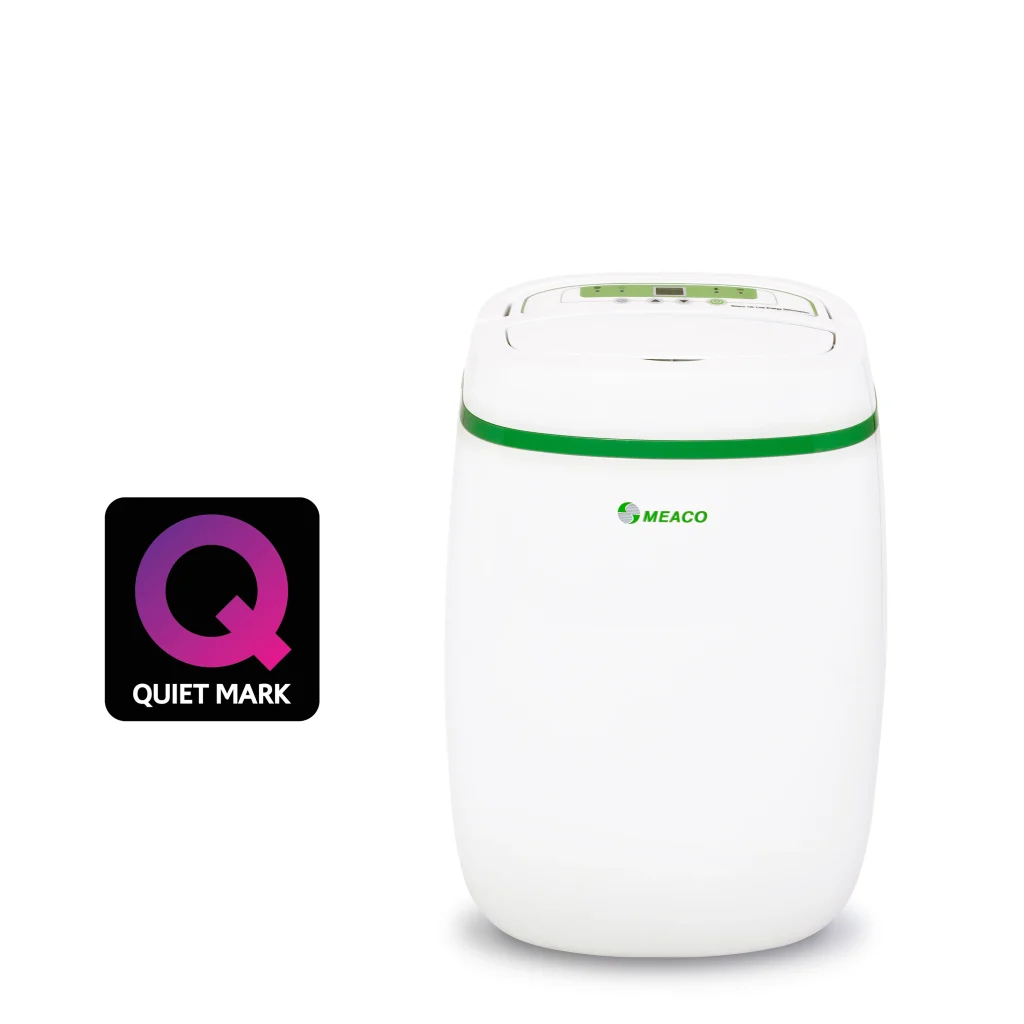
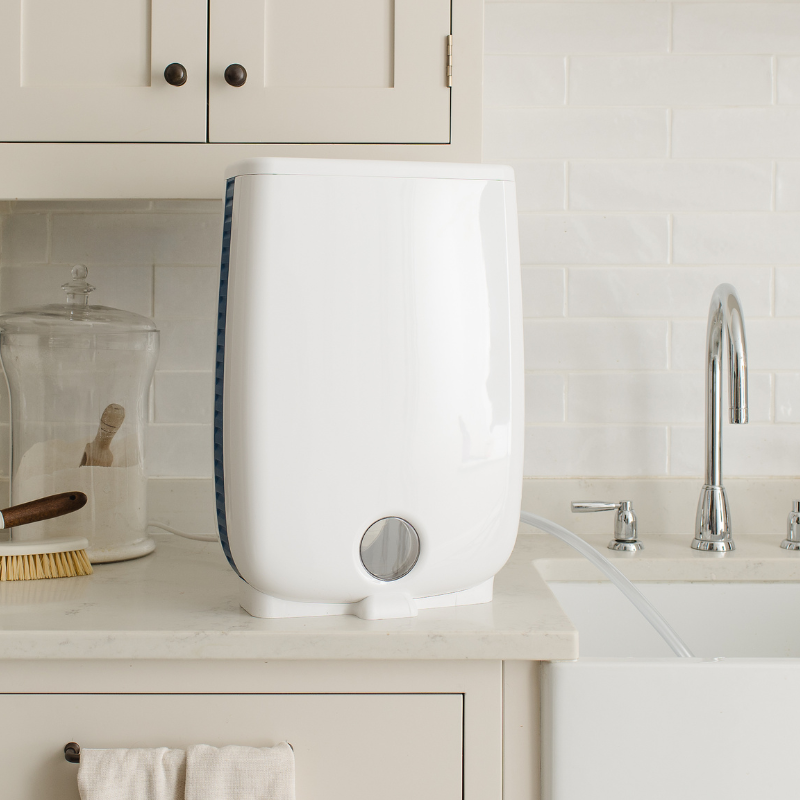



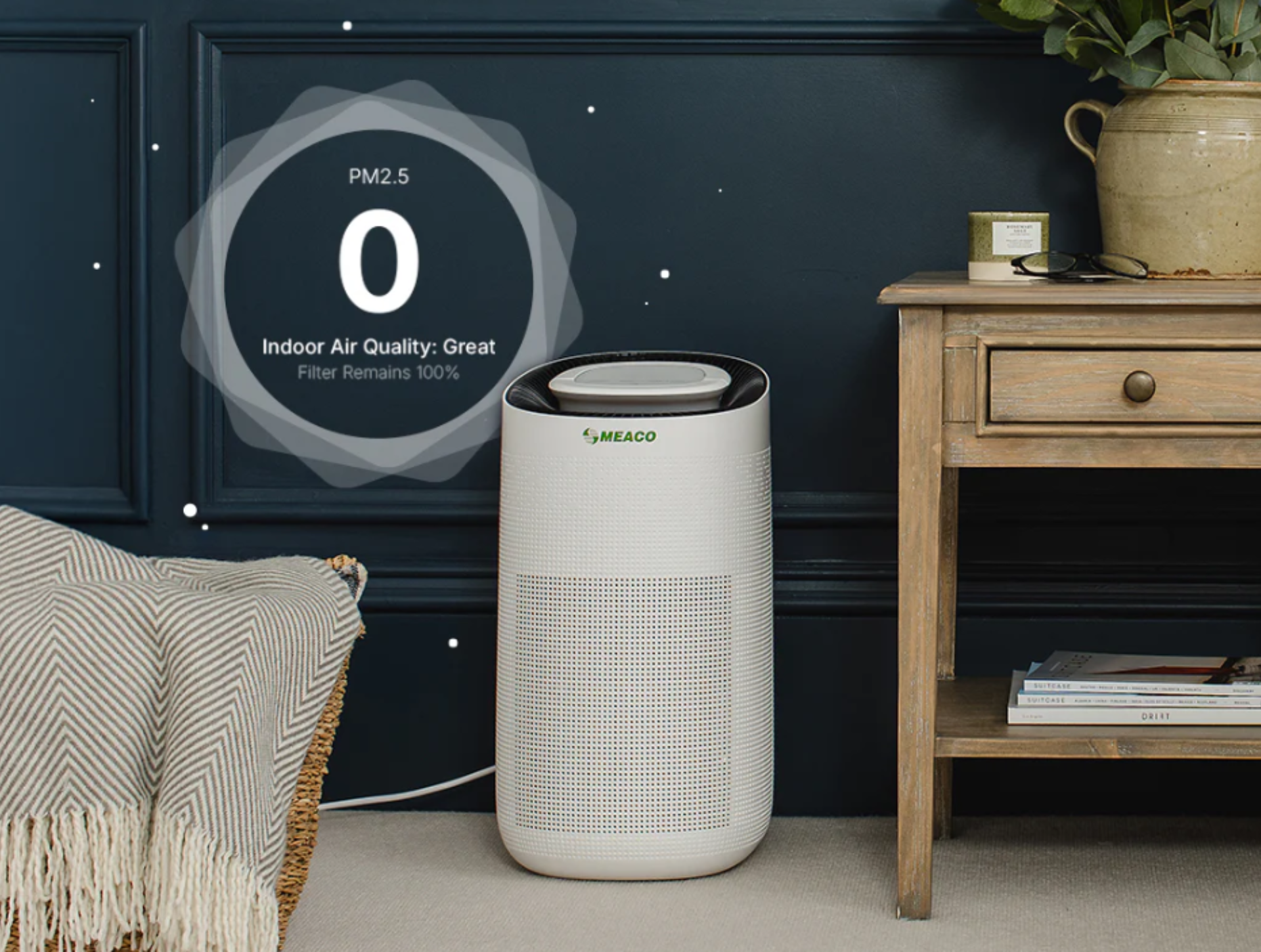



203 responses
We have a two up two down Victorian stone terrace which has condensation and mold around the windows and in the corners of the upstairs rooms. We bought the maeco arête two 12l and have been running it continuously for four days. The humidity cane down after 24 hours, but won’t budge beyond 70 and we are not extracting much water any more. We have left it on the small hallway at the top of the stairs and near the bathroom – although our upstairs is usually cold. Is it better upstairs or downstairs near the kitchen? And is it likely to come down to 55 or should we change the target level?
Kat,
Thank you for your purchase and your question.
Leave the dehumidifier set to 55%rh and put it as close to the source of the moisture as possible. What will happen for a while is that as the dehumidifier slowly dries the air, the fabric of the building will release the same amount as it dries out. This will keep the relative humidity higher, until the building is dry.
Chris
Hi
I purchased a Meaco arête one,20 Litre a couple of months ago.There is 3 adults in a 3 bedroom house. I have it in tha hall next to the bathroom and running continuously.After everyone has showered in the morning,it doesn’t seem to clear the air as the windows which are double glazed are still steamed up all the time. I have vacuumed the filter every 2 weeks as recommended.
Can you help please?
Rita,
Thank you for your purchase. Your windows are much more likely to have condensation on them at the moment because the overnight air temperatures have dropped by several degrees. You can adjust your settings downwards on the dehumidifier temporarily to something like 40%rh if you wish to try to reduce the problem.
Chris
I understand what the article is saying but my thought is yes you save money by not opening the window in one respect-you don’t have to re heat the air with your central heating but as you mention you do have to pay to run the dehumidifier, if you have gas central heating gas I understand is four times cheaper than electricity ..so I wonder if reheating the rooms air might not be cheaper..especially as I notice my room gets down to a level of humidity and then it plateaus..it’s very hard to get it from say 61% to 60%..the dehumidifier seems to run a long time to do this. If I open the windows I can knock it back very fast, 2-5 mins and maybe 10% below the target of 55%, close the window, my dehumidifier stops running sometimes for hours until the humidity climbs back up, I lose a degree or two of heat, in 15mins with the central heating I can soon get this back. I understand rooms retain most of the heat when you open a window because a lot of it is contained in the materials it’s made from “latent heat” so it’s not “all lost”. I wonder if it has to be an either/or, With central heating and dehumidifiers, can’t they be used together to greatest effect. I wish someone would do some tests on this.
Marcus,
Thank you for such in-depth comments.
Firstly, yes we agree that you save money by not opening windows, to help reduce energy costs especially in the winter, to note, a dehumidifier is designed to remove excess moisture without the need to ventilate, which can help maintain your indoor climate without relying on open windows.
Yes, it’s important to note that running any appliance, including a dehumidifier, comes with a cost. However, we do strive to make our units energy-efficient, and when used correctly, they can be an economical way to manage humidity levels. We recommend using the dehumidifier in the most efficient way possible, such as the advice given in every user manual.
Also worth adding that the dehumidifier is working to tackle humidity, not temperature. Using a dehumidifier ensures the moisture is effectively removed, which may be more efficient than just relying on heating alone.
While reheating the room’s air might feel like an option, it doesn’t address the root cause of the condensation, which is the excess moisture in the air.
Yes, reducing from 61% to 60% may take a while, especially if the air is already fairly dry. Opening windows can reduce humidity quickly, but it also brings in cold or moist air, which can lead to increased condensation over time. A dehumidifier offers continuous control over indoor humidity without relying on external weather conditions.
Dehumidifiers work to maintain optimal indoor conditions without requiring external ventilation, which is particularly helpful in colder weather when opening windows may not be ideal.
Thanks again for taking the time to share your detailed thoughts.
Kind regards,
Omar@Meaco.
Hi
Can you offer some advice please? I sent a message on the contact form on your website this morning but you may not have seen it. I purchased the 25L dehumidifier two weeks ago. 3 bedroom house, 4 occupants. Windows are 10 years old in very good condition, double glazed. I purchased the dehumidifier as the water is running down all of the upstairs windows every morning and causing mold. Week 1 I set it at 55 but the issue has not improved. Week 2 I reduced the setting to 50 but still no improvement. Water is still running on windows every morning. I have the dehumidifier on the setting to switch itself on and off as needed, plugged in all day and night on the landing with internal doors left slightly open at night. I am emptying the tank every 3 days as that is all I need to. Would a lower setting be better? I don’t want to cause more issues if I set it too low and dry the air out in the house too much but I’m lost! Thanks
Lorraine,
Thank you for using our Meaco dehumidifier.
It sounds like the condensation is likely caused by the window being very cold, which still leads to condensation despite using the dehumidifier. This issue should improve if overnight temperatures warm up later in the week.
For optimal results, try lowering the humidity level to around 40%. Keep in mind that humidity levels can fluctuate throughout the day and night, so it’s best to leave the unit running continuously. During the night, you can move the unit to the upper floor, closer to the areas with condensation, which should help improve the situation. Also, every time you empty the tank, you’re removing moisture that would otherwise be collecting on your window sills.
I hope you see some improvement, feel free to get in touch if you had any questions.
Omar@Meaco.
Thanks Omar
I am leaving the unit running continuously and have it located on the landing already which is close to the problem area. Is it okay to run it at 40 or would this make the air in the house too dry? This is all new to me and I appreciate the advice. Thanks
Why not try a window/glass vacuum? I use a dehumidifier and ventilate but I can’t tolerate the sound when I sleep so I have to switch mine off at night. In the morning some days I will get up to condensated windows if the humidity has crept up and it’s very cold outside. The first thing I do is to just clear it with the window vacuum. It’s a few minutes effort but it just helps everything out, all that moisture collected on the window is taken out of the loop (windows are not dissimilar to dehumidifiers in how they remove moisture after all) if the humidity inside is high it will start to mist again but you’re much further forward than trying to dry all that off with a dehumidifier or venting, I’d say at that point open the windows, drop the humidity naturally close them up after a few minutes and the dehumidifier is much closer to just cutting in and out to keep humidity at the target. My general rule for getting the vac on the window is if you can see drops of water ..say they are 2/3mm each..vac it..this will take forever to go..if it’s more like a frosted window look..this may well clear just by opening several sets of windows to creat a cross breeze. You don’t have to leave it all to the machine..it’s much more money that way. Window vacs are only around £50 I find them an essential tool to controlling humidity..try them after a shower on the tiles ..drying those also helps massively in keeping moisture out of the house..you often get a hole cup of water from one pass.
Marcus,
Thank you for yet again another detailed message. While a window vacuum can be effective for clearing condensation from the glass surface, it doesn’t address the underlying issue of humidity in the room itself. A dehumidifier removes excess moisture from the air, which is the root cause of condensation, ensuring long-term control of humidity and preventing further moisture build up on windows.
We understand that using a window vacuum can clear visible condensation quickly, but it only deals with surface moisture. A dehumidifier works more effectively to reduce the overall moisture in the air, which is the primary cause of condensation, preventing it from building up on your windows again. While natural ventilation can help in some cases, a dehumidifier provides consistent moisture control without relying on open windows or cross breezes.
Kind regards,
Omar@Meaco.
(Thank you again for taking the time to share your valuable comments)
Thanks for that info Marcus. I think I will take your advice and try the window vacuum. The temperatures have been good this week and I have reduced the dehumidifier to 40 but still getting a lot of condensation even with the unit running all night. Not sure if I am doing something wrong or if the dehumidifier just isn’t as good as the reviews made out!
Hello Chris, we live in an old large house and RH levels were high 65-75 – old absorbent red brick, single glassed windows, solid walls – we purchased an Arete 25 for the hallway and this really helped and then added a 20 for another bit of the house which has been equally effective. One thing that is puzzling me is that since it’s gotten colder the RH has been much easier to keep low 50-55 where as in the summer and spring both dehumidifiers needed to be on almost constantly to get anywhere below 50. Should I not be concerned about high RH levels in the spring/summer? Obviously for heating in the summer RH is less of an issue but part of the reason I want to keep RH low is to keep the house healthy, free of mould and decay etc. Most people seem to have more issues with RH in winter but my issues seems to be the reverse, any ideas why this is the case?
Dave,
Thank you for your question. Certainly understand the concern for maintaining a healthy indoor humidity level.
In general, higher RH levels are more common in the warmer months because warmer air can hold more moisture. During colder months, the air is naturally drier. It’s true that maintaining a lower RH is essential for preventing mould growth and protecting your home from damage. One possible explanation for your experience is that you may have less moisture build-up in your home during the colder months, possibly due to less ventilation or lower external humidity levels. In contrast, in warmer months, when windows are open more frequently or humidity from outdoor sources is higher, it can increase moisture levels inside more quickly.
I hope this helps clarify things!
Omar@Meaco.
Hi Omar
Thanks so much for your advice, my son insists on closing his bedroom door at night while he is sleeping as he likes the quiet and also to avoid my snoring 🤣, would you recommend another dehumidifier for his room during the night time hours or would the running of the 20l one on landing/hallway be sufficient.
Malcolm,
Thank you for your message, and I’m glad the advice has been helpful!
In terms of your son’s room, a dehumidifier running overnight can be beneficial if there’s noticeable moisture or dampness in the room. However, if your 20L unit running in the hallway or landing is effectively managing the humidity in the rest of the house, including his bedroom, then there’s no immediate need for another unit.
If your son’s room has specific moisture issues or tends to be more humid, you might want to consider adding a dehumidifier there, an Arete 10L for example.
I hope that helps.
Omar@Meaco.
I am confused re trickle vents . As it’s now winter I have brought my Meaco DD8L back in to play I use this to dry laundry and it’s fantastic and have it in my hallway with my doors open . I only run it during the day – should/can I have my trickle vents open too when this is running for fresh air ? Just wondering as it seems to run for longer when it’s raining outside .
Sarah,
Thank you for your enquiry. When using the Meaco DD8L, it’s generally a good idea to have your trickle vents open for fresh air, as this can help with air circulation. However, during rainy weather, the humidity levels can be higher outside, which might cause the dehumidifier to run longer as it works to maintain the desired humidity level indoors.
If you notice it’s running too frequently, try selecting a space of at least 4m² for drying your laundry. The smaller the air volume in the room, the quicker the dehumidifier will lower the relative humidity, creating the best conditions for drying clothes.
I hope that helps,
Omar@Meaco.
Thank you for the clarification re the trickle vents during non washing times – it does make sense now I think of it that if it’s raining I’m just letting more damp air in and hence it’s running longer . I’ll just have them open on a dry day . I normally open the bedroom ones at night anyway when the machine is off and I’m asleep . I will say though that the ‘cold’ feeling in the back of my flat has disappeared using the machine during the day – long may this continue
Hi Chris,
We have the usual problem of finding windows heavily misted up and dripping water in the morning when we get up. But it’s not a problem every morning. Sometimes there’s nothing at all, which makes me wonder if climate or living near the coast is the problem. We also have suspended flooring in our 2 bed bungalow with a 1m void under the floorboards/joists where the air would presumably be similar to that outside. My obvious question is will a dehumidifier solve the problem. Our total floor area is approx 70m2, so would the Arete 20L be the best choice?
Hi Bill,
Thanks for your message. The condensation build up on your windows in the morning consist of a few factors, please see below:
1: If it’s been a cold night and the surface temperature of your windows are therefore colder, you are more likely to get condensation.
2: On the days whereby there are more of you in the house, doing things which generate more moisture in the house such as, cooking, exercising, bath/showering, kettle use and drying laundry etc. The more this happens, the more likely you will get condensation.
3: On cold days if you leave windows open, combined with having heating on in the house then you are less likely to get condensation.
When the indoor humidity levels are high, when this humid air comes into contact with the cold surface of the windows overnight, then you’ll then develop the condensation in the morning on your windows.
Whether the Arete 20L is right for you depends on the number of people in your house and the activity levels as mentioned above. Feel free to reply to this and I can establish if the Arete 20L is right for you.
Kind regards,
Omar
Hi Bill, we moved into our new build last year (small 3 bed with 2 adults and 2 children) and last winter the condensation on the windows in the mornings were terrible and I had to wipe every widow down with a towel and mould spores formed around the windows. We do not need our heating on much at all because the house is so well insulated. I would only need a dehumidifier on over night to combat this issue and also for drying laundry. Would the dehumidifier get rid of the condensation in the bedrooms if the bedroom doors are closed? Would I need to position this on the upstairs landing or could this be left on downstairs in the hallway near the stairs to do it’s job? Also, could you recommend which Meaco dehumidifier would be best for this purpose. I have researched a lot and Meaco is definitely the brand I want to buy.
Thank you! 🙂
Thank you for your enquiry,
I’d recommend using at least a 12L capacity dehumidifier.
Doors should be open in order for the air to flow and for your machine to be able to extract the moisture from the room.
Positioning the unit in the hallway is generally a good idea, it allows the machine to be in a fair reach for the rest of the home, permitting internal room doors be left open.
Have a look at our AreteOne 12L for this purpose: https://www.meaco.com/products/meacodryarete1-12l
Omar@Meaco
Hi Chris, thank you for this article. We live in a 3 bedroom 2 story house 70 m2 and we usually had 60+ humidity in the house + condensation around 2 cm at the bottom of each window. We have bought arete 20l and humidity is now around 50 – thats really great, but still there is some condensation on windows. What would you suggest we can do to get rid of it? Should I make humidity less? Thanks
This is telling you that the window is very cold and it still condenses at this low humidity (probably an older window, so less energy efficient). The problem will probably disappear when the overnight temperatures warm up later in the week. You could reduce the humidity to 40%, or just live with it until the weather improves.
Hi Chris
I have a four bedroom home fitted with triple glazing but get condensation on the bedroom windows and window frames of the two occupied bedrooms during the colder mornings in winter. The house has three accupents who reside there (me, my wife and son). I recently bought a digital hydrometer which is telling me the humidity is somewhere between 65 & 67 % in the house would you recommend a dehumidifier for the bedrooms only or a dehumidifier for the whole house. If you recommend one for the whole house where is the best place for it hallway or landing
Malcolm,
Thank you for your question! Given the humidity levels in your home and the condensation issues you’re experiencing, one dehumidifier should suffice for maintaining an optimal humidity level throughout your entire house.
Your dehumidifier can effectively reduce the overall humidity by drawing moisture from the air in all rooms, helping to minimize condensation on windows and prevent mould growth. Here are some tips to maximize its effectiveness:
Situate the dehumidifier in a central area, such as a hallway or landing.
Keep the unit running 24/7 for consistent humidity control.
Leave internal doors open to allow for better airflow.
Keep external doors and windows closed while the unit is in operation.
I recommend our Arete 20L at a minimum, or if you’re looking for the most powerful option, consider the 25L. The dimensions are the same, but the larger unit offers higher extraction rates.
If you have any more questions or need further assistance, feel free give us a call!
Kind regards,
Omar@Meaco.